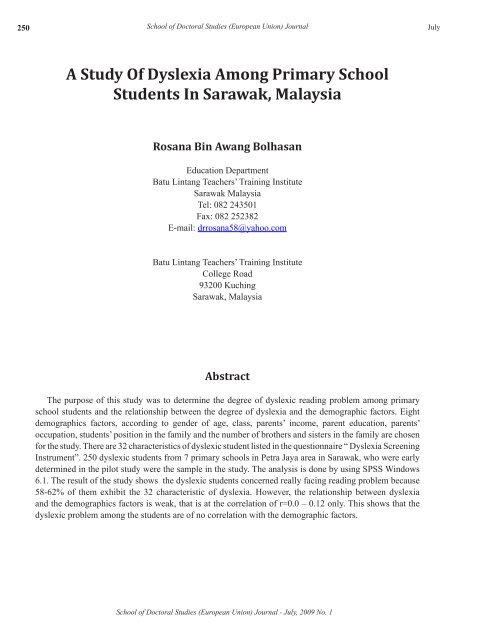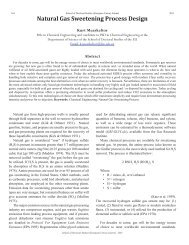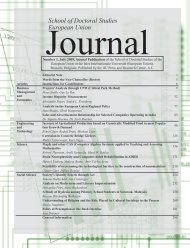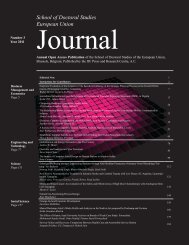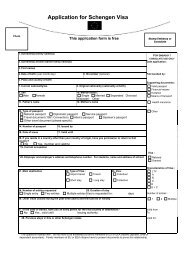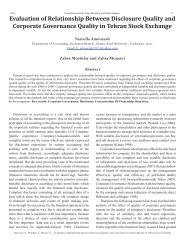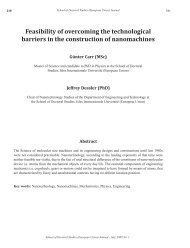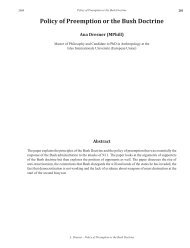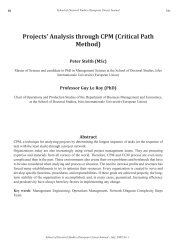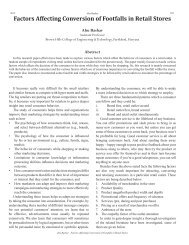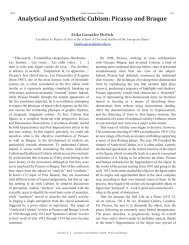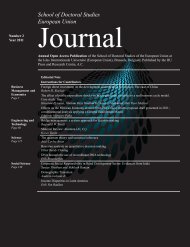A Study of Dyslexia among Primary School Students in Sarawak ...
A Study of Dyslexia among Primary School Students in Sarawak ...
A Study of Dyslexia among Primary School Students in Sarawak ...
- No tags were found...
Create successful ePaper yourself
Turn your PDF publications into a flip-book with our unique Google optimized e-Paper software.
250<br />
<strong>School</strong> <strong>of</strong> Doctoral Studies (European Union) Journal<br />
July<br />
A <strong>Study</strong> Of <strong>Dyslexia</strong> Among <strong>Primary</strong> <strong>School</strong><br />
<strong>Students</strong> In <strong>Sarawak</strong>, Malaysia<br />
Rosana B<strong>in</strong> Awang Bolhasan<br />
Education Department<br />
Batu L<strong>in</strong>tang Teachers’ Tra<strong>in</strong><strong>in</strong>g Institute<br />
<strong>Sarawak</strong> Malaysia<br />
Tel: 082 243501<br />
Fax: 082 252382<br />
E-mail: drrosana58@yahoo.com<br />
Batu L<strong>in</strong>tang Teachers’ Tra<strong>in</strong><strong>in</strong>g Institute<br />
College Road<br />
93200 Kuch<strong>in</strong>g<br />
<strong>Sarawak</strong>, Malaysia<br />
Abstract<br />
The purpose <strong>of</strong> this study was to determ<strong>in</strong>e the degree <strong>of</strong> dyslexic read<strong>in</strong>g problem <strong>among</strong> primary<br />
school students and the relationship between the degree <strong>of</strong> dyslexia and the demographic factors. Eight<br />
demographics factors, accord<strong>in</strong>g to gender <strong>of</strong> age, class, parents’ <strong>in</strong>come, parent education, parents’<br />
occupation, students’ position <strong>in</strong> the family and the number <strong>of</strong> brothers and sisters <strong>in</strong> the family are chosen<br />
for the study. There are 32 characteristics <strong>of</strong> dyslexic student listed <strong>in</strong> the questionnaire “ <strong>Dyslexia</strong> Screen<strong>in</strong>g<br />
Instrument”. 250 dyslexic students from 7 primary schools <strong>in</strong> Petra Jaya area <strong>in</strong> <strong>Sarawak</strong>, who were early<br />
determ<strong>in</strong>ed <strong>in</strong> the pilot study were the sample <strong>in</strong> the study. The analysis is done by us<strong>in</strong>g SPSS W<strong>in</strong>dows<br />
6.1. The result <strong>of</strong> the study shows the dyslexic students concerned really fac<strong>in</strong>g read<strong>in</strong>g problem because<br />
58-62% <strong>of</strong> them exhibit the 32 characteristic <strong>of</strong> dyslexia. However, the relationship between dyslexia<br />
and the demographics factors is weak, that is at the correlation <strong>of</strong> r=0.0 – 0.12 only. This shows that the<br />
dyslexic problem <strong>among</strong> the students are <strong>of</strong> no correlation with the demographic factors.<br />
<strong>School</strong> <strong>of</strong> Doctoral Studies (European Union) Journal - July, 2009 No. 1
2009 A <strong>Study</strong> <strong>of</strong> <strong>Dyslexia</strong> <strong>among</strong> <strong>Primary</strong> <strong>School</strong> <strong>Students</strong> <strong>in</strong> <strong>Sarawak</strong>, Malaysia<br />
251<br />
Intoduction<br />
<strong>Dyslexia</strong> is a language disability, affect<strong>in</strong>g<br />
read<strong>in</strong>g, writ<strong>in</strong>g, speak<strong>in</strong>g and listen<strong>in</strong>g. It<br />
is a dysfunction or impairment <strong>in</strong> the use <strong>of</strong><br />
words. Consequently, relation with others and<br />
performance <strong>in</strong> every subject <strong>in</strong> school can be<br />
affected by dyslexia. It can be found around the<br />
world pr<strong>in</strong>cipally <strong>among</strong> boys. It exists <strong>in</strong> learners<br />
<strong>of</strong> slow, average and superior <strong>in</strong>telligence. The<br />
dyslexic child can come from any background or<br />
any <strong>in</strong>come level and dyslexia may occur <strong>in</strong> any<br />
child <strong>in</strong> a family regardless <strong>of</strong> order <strong>in</strong> which he<br />
is born.<br />
Like other countries, <strong>in</strong> Malaysia, read<strong>in</strong>g is<br />
one <strong>of</strong> the skills required <strong>in</strong> the study <strong>of</strong> language.<br />
It is the important skill <strong>in</strong> the hierarchy <strong>of</strong> the<br />
Malaysian Education syllabus. It is very essential<br />
and considered to be one way to evaluate the<br />
success <strong>of</strong> students <strong>in</strong> their learn<strong>in</strong>g <strong>in</strong> schools. In<br />
the <strong>in</strong>tegrated curriculum <strong>of</strong> Secondary <strong>School</strong>s,<br />
read<strong>in</strong>g ability is <strong>of</strong> prime importance besides<br />
the skills <strong>in</strong> arithmetic and writ<strong>in</strong>g. The ability to<br />
read is not only considered as basis to achiev<strong>in</strong>g<br />
success <strong>in</strong> other learn<strong>in</strong>g processes but <strong>in</strong>clud<strong>in</strong>g<br />
this skill this ma<strong>in</strong> skill <strong>of</strong> read<strong>in</strong>g <strong>in</strong> the Education<br />
System is proven to be the factor <strong>of</strong> success from<br />
primary to higher <strong>in</strong>stitutional level.<br />
Amir Awang (1995) quoted that students ability<br />
is one <strong>of</strong> the factors that contribute <strong>of</strong> their learn<strong>in</strong>g<br />
widely <strong>in</strong> the other areas <strong>of</strong> knowledge. F<strong>in</strong>d<strong>in</strong>gs<br />
from research study on read<strong>in</strong>g still persist until<br />
today that it has great bear<strong>in</strong>g on achievement <strong>in</strong><br />
various areas <strong>of</strong> acquir<strong>in</strong>g knowledge. It is proven<br />
that students who are able to read usually have<br />
great potentiality <strong>in</strong> their studies.<br />
Accord<strong>in</strong>g to Bond & T<strong>in</strong>ker (1987) read<strong>in</strong>g<br />
ability considered to be <strong>of</strong> paramount importance<br />
which ties the bond <strong>of</strong> <strong>in</strong>teraction which enables<br />
people to communicate with one another. Smith<br />
(1973) had dwelled <strong>in</strong> depth on “psychol<strong>in</strong>guistic<br />
communication” <strong>in</strong> correlation with read<strong>in</strong>g<br />
process from the view <strong>of</strong> psychol<strong>in</strong>guistics.<br />
In general it has three views which have been<br />
supported by l<strong>in</strong>guists and cognitive psychologists.<br />
Their views are:<br />
a. There need to be only small portion <strong>of</strong> the<br />
<strong>in</strong>formation that requires understand<strong>in</strong>g<br />
from pr<strong>in</strong>ted text.<br />
b. Understand<strong>in</strong>g must proceed vocabulary<br />
c. Read<strong>in</strong>g is not to decode written language<br />
from that <strong>of</strong> oral.<br />
Our nation’s educational experts have much<br />
effort <strong>in</strong> promot<strong>in</strong>g and develop<strong>in</strong>g the skills <strong>of</strong><br />
read<strong>in</strong>g and <strong>in</strong>terpret<strong>in</strong>g, especially <strong>in</strong> the Malay<br />
Language subject. However, the adversity <strong>in</strong><br />
read<strong>in</strong>g ability <strong>among</strong>st students <strong>in</strong> the primary and<br />
lower secondary school still prevails. Accord<strong>in</strong>g<br />
to Mohd. Fadzil Haji Hassan (1998) the problem<br />
<strong>of</strong> student disability <strong>in</strong> read<strong>in</strong>g <strong>in</strong> schools has not<br />
been solved and so far cannot be overcome.<br />
<strong>Students</strong> be<strong>in</strong>g unable to read and dislike<br />
read<strong>in</strong>g is a topic <strong>of</strong> conversation that is <strong>of</strong>ten<br />
brought up by the various communities. Abdul<br />
Halim Yusuf (1995) quoted:<br />
Recently questions about the <strong>in</strong>crease <strong>in</strong> the<br />
number <strong>of</strong> students<br />
who cannot read and dislike read<strong>in</strong>g news<br />
from the media<br />
reveals that many students do not have the<br />
read<strong>in</strong>g skill.<br />
Lately, the media has reported that students<br />
are not pr<strong>of</strong>icient <strong>in</strong> read<strong>in</strong>g. Various authorities<br />
voiced their concern about the phenomenon <strong>of</strong><br />
students hav<strong>in</strong>g low read<strong>in</strong>g pr<strong>of</strong>iciency. The<br />
Malaysian M<strong>in</strong>istry <strong>of</strong> Education, parents and<br />
teachers have voiced out their concern over the<br />
newspaper (S<strong>of</strong>iah Hamid, 1999). Accord<strong>in</strong>g to the<br />
report from the Director General <strong>of</strong> The Malaysian<br />
Education M<strong>in</strong>istry, there are about 6,000 <strong>of</strong><br />
primary 6 students who cannot read properly.<br />
In view <strong>of</strong> the importance <strong>of</strong> read<strong>in</strong>g skill<br />
which necessarily acquired as the basic skill as<br />
well as the unsolved problems about dyslexia, a<br />
thorough study needs to be carried.<br />
Accord<strong>in</strong>g to Kamarud<strong>in</strong> Hj. Huss<strong>in</strong> (1980)<br />
cases on dyslexia are <strong>in</strong>creas<strong>in</strong>g. It happens <strong>in</strong> the<br />
primary school and lower secondary schools. To<br />
address this problem, the M<strong>in</strong>istry <strong>of</strong> Education<br />
has taken steps such as:<br />
Rosana B<strong>in</strong> Awang Bolhasan - A <strong>Study</strong> <strong>of</strong> <strong>Dyslexia</strong> <strong>among</strong> <strong>Primary</strong> <strong>School</strong> <strong>Students</strong> <strong>in</strong> <strong>Sarawak</strong>, Malaysia
252<br />
<strong>School</strong> <strong>of</strong> Doctoral Studies (European Union) Journal<br />
July<br />
a. Conduct<strong>in</strong>g courses on read<strong>in</strong>g for<br />
primary school teachers.<br />
b. Introduc<strong>in</strong>g special project on remedial and<br />
<strong>in</strong>centive studies <strong>in</strong> 1975 by Centre<br />
<strong>of</strong> Advanced Curriculum.<br />
c. Organiz<strong>in</strong>g and conduct<strong>in</strong>g workshops and<br />
sem<strong>in</strong>ars ton address the problem.<br />
d. All projects be<strong>in</strong>g planned are <strong>in</strong> collaboration<br />
with Faculty <strong>of</strong> Education<br />
University Malaya.<br />
e. Many education <strong>of</strong>fices carry out remedial<br />
program on the Malay language subject.<br />
f. Teachers Tra<strong>in</strong><strong>in</strong>g College for special<br />
education successfully organized courses<br />
on methodology for teacher tra<strong>in</strong>ees.<br />
Although the Education M<strong>in</strong>istry has taken<br />
various steps to tackle the problem on dyslexia, it<br />
has not been able to overcome it successfully. The<br />
curriculum division has come up with a f<strong>in</strong>d<strong>in</strong>g<br />
that primary six students <strong>in</strong> the school below have<br />
received certa<strong>in</strong> percentage <strong>of</strong> success:<br />
a. The Ch<strong>in</strong>ese National <strong>School</strong> 50.5%<br />
b. The Tamale National <strong>School</strong> 50.8%<br />
(Hasmah Ud<strong>in</strong>, 1998)<br />
This phenomenon has a great set back. Due<br />
to that, the M<strong>in</strong>istry <strong>of</strong> Education <strong>in</strong>troduces<br />
the new Curriculum for primary school, which<br />
focuses ma<strong>in</strong>ly on read<strong>in</strong>g, writ<strong>in</strong>g and arithmetic<br />
(Kementerian Pendidikan Malaysia, 1998:1).<br />
It is hoped by the end <strong>of</strong> the primary school<br />
level, students are able to adapt themselves <strong>in</strong>to<br />
develop<strong>in</strong>g th<strong>in</strong>k<strong>in</strong>g process.<br />
Follow<strong>in</strong>g the new primary school curriculum,<br />
the Cab<strong>in</strong>et Committee has come up with the new<br />
Education Policy or System formulated a new<br />
Curriculum <strong>of</strong> secondary school to replace the<br />
previous one. This has come up with the stress on<br />
speak<strong>in</strong>g, read<strong>in</strong>g and writ<strong>in</strong>g pr<strong>of</strong>iciently as well<br />
as be<strong>in</strong>g creative <strong>in</strong> handl<strong>in</strong>g situation.<br />
Musa Jalil (1989) has found out that 40% <strong>of</strong><br />
the primary 6 students <strong>in</strong> Pulau P<strong>in</strong>ang cannot<br />
read well. There are 15,728 students, 2573 cannot<br />
read, 2,105 can read but without the ability to<br />
comprehend the text they read. His study has<br />
come up with a number, 6,668 out <strong>of</strong> 15,728 who<br />
cannot master the basic skill <strong>of</strong> read<strong>in</strong>g and are<br />
almost illiterate.<br />
This has been proven through the weaknesses<br />
<strong>of</strong> the new primary school curriculum. It has not<br />
encouraged the student to strive harder and proven<br />
to have no bear<strong>in</strong>g at all to improve the situation.<br />
It means the student spend fruitless sessions <strong>in</strong><br />
their schools for the whole 6 years <strong>in</strong> the primary<br />
education.<br />
This situation has raised the level on anxiety<br />
<strong>among</strong>st educationists, parents and the society.<br />
Be<strong>in</strong>g not able to possess a good pr<strong>of</strong>iciency <strong>in</strong><br />
read<strong>in</strong>g, students will not be able to refer and<br />
learn much from text books <strong>in</strong> order acquire other<br />
knowledge on other genre. It has been proven that<br />
students fail <strong>in</strong> their exam<strong>in</strong>ations just because<br />
they cannot understand or comprehend the<br />
questions. Due to this problem, <strong>in</strong> depth study is<br />
necessary to be carried out so that the real problem<br />
can be <strong>in</strong>dentified. The details <strong>of</strong> the problems can<br />
be looked upon from the follow<strong>in</strong>g po<strong>in</strong>ts <strong>of</strong> view<br />
and this research objectives are ma<strong>in</strong>ly focused<br />
on the problem <strong>of</strong> dyslexia <strong>among</strong>st students<br />
<strong>in</strong> the primary school <strong>Sarawak</strong>, Malaysia. The<br />
specification <strong>of</strong> this study are the highlight<strong>in</strong>g <strong>of</strong>:<br />
a. The frequent dyslexia characteristics exhibited<br />
by the dyslexic students.<br />
b. The relationship between the degree <strong>of</strong><br />
dyslexia faced by the student and their<br />
demographics factors.<br />
c. The significant difference between male and<br />
female dyslexic.<br />
All these aspects are the focus <strong>of</strong> this case<br />
study with the hope that all can be solved, hav<strong>in</strong>g<br />
come up with a guide to remedy the situation with<br />
systematic well-planned approaches.<br />
Method<br />
The data for this research was collected from<br />
the District <strong>of</strong> Petra Jaya, <strong>in</strong> the state <strong>of</strong> <strong>Sarawak</strong>,<br />
Malaysia. The district was selected because it<br />
<strong>School</strong> <strong>of</strong> Doctoral Studies (European Union) Journal - July, 2009 No. 1
2009 A <strong>Study</strong> <strong>of</strong> <strong>Dyslexia</strong> <strong>among</strong> <strong>Primary</strong> <strong>School</strong> <strong>Students</strong> <strong>in</strong> <strong>Sarawak</strong>, Malaysia<br />
253<br />
meets the requirement <strong>of</strong> the ma<strong>in</strong> focus <strong>of</strong> the<br />
study <strong>in</strong> terms <strong>of</strong> demographical features.<br />
Further more, one pilot study had been made<br />
before the actual research was done. The pilot study<br />
is to certify the researched subject is be<strong>in</strong>g made<br />
through <strong>in</strong>terview with the pr<strong>in</strong>cipal, the remedial<br />
teachers and other teachers who are teach<strong>in</strong>g them,<br />
besides observation <strong>of</strong> the students who had been<br />
notified. This study <strong>in</strong>volved 250 dyslexic students<br />
and this sample has been confirmed through the<br />
pilot study at the early stage <strong>of</strong> the research.<br />
Besides us<strong>in</strong>g the students sample, the<br />
researcher also distributed questionnaire to the 25<br />
teachers who are <strong>in</strong> charge <strong>of</strong> every subject, and<br />
the class teachers to f<strong>in</strong>d out about their perception<br />
toward the students. The age <strong>of</strong> those dyslexic<br />
students range 7 to 12 years and were from 7<br />
primary schools.<br />
The pilot study s carried out after <strong>in</strong>terview<br />
with those teachers who teach them. <strong>Students</strong> that<br />
have been analyzed are been observed. In this<br />
observation, the students characteristic as set <strong>in</strong><br />
<strong>Dyslexia</strong> Screen<strong>in</strong>g Instrument were detected. In<br />
the pilot study report from teachers and the students’<br />
work are also <strong>in</strong>cluded as criteria to ascerta<strong>in</strong> if the<br />
students is suffer<strong>in</strong>g from dyslexia.<br />
At first, the researcher distributed questionnaire<br />
to the dyslexic students and asked them to write their<br />
name <strong>in</strong> the questionnaire. Then, the researcher<br />
distributed the same questionnaire to the class<br />
teacher and asked them to evaluate the students.<br />
The teachers’ perception is important because<br />
accord<strong>in</strong>g to Abang Ridzuan (1991), “Class<br />
teacher is one who knows well about the problems<br />
<strong>among</strong> the students besides their attitude”. In an<br />
<strong>in</strong>direct way, teacher’s perception can be used as a<br />
control for the students’ op<strong>in</strong>ions.<br />
The “<strong>Dyslexia</strong> Screen<strong>in</strong>g Instrument” by<br />
Kathryn B. Choon et al (1994) is a rat<strong>in</strong>g scale<br />
designed to describe the cluster <strong>of</strong> characteristics<br />
associated with dyslexia and to discrim<strong>in</strong>ate<br />
between students who display these characteristics<br />
and students who do not. This scale, for use <strong>in</strong> the<br />
school sett<strong>in</strong>g, is quick and non <strong>in</strong>trusive, and<br />
provides education pr<strong>of</strong>essionals with a start<strong>in</strong>g<br />
po<strong>in</strong>t for identify<strong>in</strong>g students at risk for dyslexia.<br />
The <strong>Dyslexia</strong> Screen<strong>in</strong>g Instrument is designed<br />
to be used with students <strong>in</strong> grade 1 through 12<br />
(ages 6 through 21). It can be used to screen entire<br />
population <strong>of</strong> students or students who exhibit<br />
read<strong>in</strong>g, spell<strong>in</strong>g, writ<strong>in</strong>g or language-process<strong>in</strong>g<br />
difficulties. Rat<strong>in</strong>g and scor<strong>in</strong>g should take 15 to<br />
20 m<strong>in</strong>utes per student.<br />
A classroom teacher who has worked directly<br />
with the student for at least six weeks should<br />
complete the Rat<strong>in</strong>g Form. This will result <strong>in</strong><br />
a rat<strong>in</strong>g that will be more accurate because the<br />
teacher has observed the student over a lengthy<br />
period <strong>of</strong> time and can compare the students’<br />
performance to that <strong>of</strong> the students; classmate.<br />
For an elementary student, the prefer rater is<br />
the teacher who <strong>in</strong>structs the student <strong>in</strong> a variety<br />
<strong>of</strong> subjects. For a middle school or high school<br />
student, the prefer rater a language teacher who<br />
generally has more opportunity to observe the<br />
behavior that is <strong>in</strong>dicative <strong>of</strong> dyslexia.<br />
The pr<strong>of</strong>essional who is <strong>in</strong> charge <strong>of</strong> gather<strong>in</strong>g<br />
<strong>in</strong>formation about the student should expla<strong>in</strong> to<br />
the rater that the purpose <strong>of</strong> the Rat<strong>in</strong>g Form is<br />
to obta<strong>in</strong> an accurate picture <strong>of</strong> current student<br />
performance related to specific characteristics.<br />
The pr<strong>of</strong>essional also should make sure the rater<br />
understand how to complete the Rat<strong>in</strong>g Form and<br />
what each statement describes.<br />
The rater should complete the student<br />
<strong>in</strong>formation on the front <strong>of</strong> the Rat<strong>in</strong>g Form. Not<br />
all <strong>of</strong> the <strong>in</strong>formation is required for scor<strong>in</strong>g, but it<br />
may be useful for record-keep<strong>in</strong>g purposes.<br />
a.<br />
b.<br />
c.<br />
d.<br />
e.<br />
Never exhibits<br />
Seldom exhibits<br />
Sometimes exhibits<br />
Often exhibits<br />
Always exhibits<br />
Besides that, a questionnaire is used to<br />
recognize especially the Socio-economic status <strong>of</strong><br />
the students family. The items are:<br />
a.<br />
b.<br />
c.<br />
d.<br />
e.<br />
Gender<br />
Age<br />
Level <strong>of</strong> study<br />
Occupation <strong>of</strong> Parent/Guardian<br />
Education <strong>of</strong> Parent/Guardian<br />
Rosana B<strong>in</strong> Awang Bolhasan - A <strong>Study</strong> <strong>of</strong> <strong>Dyslexia</strong> <strong>among</strong> <strong>Primary</strong> <strong>School</strong> <strong>Students</strong> <strong>in</strong> <strong>Sarawak</strong>, Malaysia
254<br />
<strong>School</strong> <strong>of</strong> Doctoral Studies (European Union) Journal<br />
July<br />
f.<br />
g.<br />
The number <strong>of</strong> brothers<br />
Family status<br />
Questions Management<br />
The <strong>in</strong>strument that is used is a questionnaire,<br />
which was translated from its orig<strong>in</strong>al <strong>in</strong>strument<br />
“<strong>Dyslexia</strong> Screen<strong>in</strong>g Instrument”. Both versions,<br />
English (orig<strong>in</strong>al) and Malay Language (Translated<br />
are attached). The questionnaire is made <strong>in</strong>to two<br />
groups which conta<strong>in</strong> similar question. The first<br />
set is for the students and second set is for the<br />
teachers.<br />
Evaluation<br />
Evaluation is made accord<strong>in</strong>g to evaluation<br />
procedure, especially the explanation for every<br />
statement which is written <strong>in</strong> the questionnaire.<br />
Both questionnaires need to be completed <strong>in</strong> 15 to<br />
20 m<strong>in</strong>utes only. The fill<strong>in</strong>g <strong>in</strong> the demographic<br />
questionnaire and the questionnaire for students<br />
who suffer from dyslexia must be carried out<br />
by the help from the teacher and the researcher.<br />
Detail explanation about their needs followed by<br />
the mean<strong>in</strong>g <strong>of</strong> a statement must be carried out<br />
and it is students preference to choose their scale<br />
accord<strong>in</strong>g to their own valuation. Teachers who<br />
are <strong>in</strong>volved must have experience <strong>in</strong> teach<strong>in</strong>g the<br />
students for at least 6 weeks. It can help the teacher<br />
to make an observation followed by compar<strong>in</strong>g<br />
their potential with their friends. It makes two<br />
months to complete the questionnaire.<br />
Data Analysis<br />
The questionnaire that are filled <strong>in</strong> are collected<br />
for analysis. Both <strong>of</strong> the students and teachers<br />
valuation are put together for every respondent.<br />
Every respondent is evaluated accord<strong>in</strong>g to every<br />
item <strong>in</strong> the questionnaire and written down <strong>in</strong><br />
both valuation scales. One type <strong>of</strong> analysis from<br />
is modified to simplify the analysis. Here is the<br />
example <strong>of</strong> simple procedure by us<strong>in</strong>g the analysis<br />
form.<br />
Table 1 Analysis Data Code<br />
ITEM 1 ITEM 2 ITEM 3<br />
A B A B A B<br />
Respondent 1 2 1 3 4 2 2<br />
Respondent 2 1 1 2 3 3 4<br />
Respondent 3 1 2 3 2 2 2<br />
There is data analysis from 250 respondents and<br />
the items are from 1 to 33. Teacher’s valuations<br />
are <strong>in</strong> (A) and the student’s valuations are <strong>in</strong><br />
(B). The demographic questionnaire has been<br />
accomplished and analyzed. All data has been<br />
processed for frequency, correlation, regression<br />
followed by T-test by us<strong>in</strong>g SPSS W<strong>in</strong>dow 6.1.<br />
Frequency analysis is a prepared list <strong>of</strong><br />
quantitative data and this is done by list<strong>in</strong>g, <strong>in</strong><br />
rank order from high to low, all the scores to be<br />
summarized, with tallies to <strong>in</strong>dicate the number <strong>of</strong><br />
subjects receiv<strong>in</strong>g each score. The scores <strong>in</strong> a<br />
distribution are grouped <strong>in</strong>to <strong>in</strong>tervals. To further<br />
the understand<strong>in</strong>g and <strong>in</strong>terpretation <strong>of</strong> data, it will<br />
be presented <strong>in</strong> frequency polygon with frequency<br />
analysis. In this context, frequent act by the<br />
students who suffer from dyslexia can be detected<br />
easily and frequent analysis characteristics can be<br />
also recognized.<br />
With correlation, researcher seeks to determ<strong>in</strong>e<br />
if relationship exists between two or more variables.<br />
By compar<strong>in</strong>g the performance <strong>of</strong> different groups<br />
is the way to study relationships. Sometimes,<br />
such relationships are useful <strong>in</strong> prediction, but<br />
most <strong>of</strong>ten the eventual goal is to say someth<strong>in</strong>g<br />
about causation (Jack R. Fraenkel and Norman E.<br />
Wallen, 1990:158).<br />
Correlation coefficients can take on values<br />
from – 1.00 to + 1.00 <strong>in</strong>clusive; the greater the<br />
absolute value <strong>of</strong> the coefficient, the stronger the<br />
relationship. A correlation coefficient <strong>of</strong> zero<br />
<strong>in</strong>dicates no relationship or <strong>in</strong>dependence <strong>of</strong> the<br />
variables. In the context <strong>of</strong> this study correlation is<br />
used to seek relationship between the demographic<br />
factor and the characteristics which have been<br />
shown by the dyslexia students.<br />
Regression analysis allows the researcher to<br />
work out whether two variables are associated,<br />
whether people who vary on one variable also<br />
<strong>School</strong> <strong>of</strong> Doctoral Studies (European Union) Journal - July, 2009 No. 1
2009 A <strong>Study</strong> <strong>of</strong> <strong>Dyslexia</strong> <strong>among</strong> <strong>Primary</strong> <strong>School</strong> <strong>Students</strong> <strong>in</strong> <strong>Sarawak</strong>, Malaysia<br />
255<br />
vary systematically on the <strong>of</strong>fer (D.A.de Vaus,<br />
1995: 179). The researcher also can determ<strong>in</strong>e<br />
how strongly these variables are associated. It also<br />
enables the researcher to say how much impact<br />
each unit change <strong>in</strong> the <strong>in</strong>dependent variable has<br />
on the dependent variable.<br />
In summary, the regression coefficient can<br />
be used to measure the amount <strong>of</strong> impact or<br />
change one variable produces <strong>in</strong> another. They<br />
are asymmetrical and will be different accord<strong>in</strong>g<br />
to which variable id <strong>in</strong>dependent. In this study,<br />
regression will be used to see the most valuable<br />
changes or the ma<strong>in</strong> <strong>in</strong>fluence <strong>of</strong> dyslexia.<br />
The t-test provides a method by which the<br />
means <strong>of</strong> the samples can be compared when it<br />
is assumed that the samples have been randomly<br />
selected and the score are obta<strong>in</strong>ed from normally<br />
distributed population (Gajendra K. Verma and<br />
Kanka Mallick, 1999:205). Use <strong>of</strong> the test enables<br />
researcher to say whether the difference obta<strong>in</strong>ed<br />
is quite likely to occur by chance, or whether it is<br />
significant. In the latter case, the difference may<br />
be due to some underly<strong>in</strong>g cause which deserves<br />
further <strong>in</strong>vestigation.<br />
This is case study research. After pilot<br />
study, with <strong>in</strong>terview and observation done, sets<br />
<strong>of</strong> questionnaires are produced for the actual<br />
research. The whole procedure <strong>of</strong> the research is<br />
as <strong>in</strong> Figure 1 below.<br />
Figure 1: Research Graphic Procedure<br />
Pilot <strong>Study</strong><br />
(Interview)<br />
Pilot <strong>Study</strong><br />
(Observation)<br />
Pilot Analysis<br />
<strong>Study</strong><br />
Construct<strong>in</strong>g Instrument<br />
Accord<strong>in</strong>g to validity and reliability<br />
Applied <strong>in</strong> the study<br />
15<br />
Product <strong>of</strong> study<br />
Rosana B<strong>in</strong> Awang Bolhasan - A <strong>Study</strong> <strong>of</strong> <strong>Dyslexia</strong> <strong>among</strong> <strong>Primary</strong> <strong>School</strong> <strong>Students</strong> <strong>in</strong> <strong>Sarawak</strong>, Malaysia
256<br />
<strong>School</strong> <strong>of</strong> Doctoral Studies (European Union) Journal<br />
July<br />
Result<br />
The result <strong>of</strong> the research on dyslexia has<br />
been experienced by the respondents <strong>in</strong> the<br />
primary school level. The question that is go<strong>in</strong>g<br />
to be answered is, ‘Are the demographic factors<br />
like the economic level <strong>of</strong> the parents <strong>in</strong>fluence all<br />
dyslexia characteristics.<br />
The ma<strong>in</strong> purpose <strong>of</strong> describ<strong>in</strong>g these variables<br />
was to provide some <strong>in</strong>sight <strong>in</strong>to the characteristic<br />
<strong>of</strong> dyslexia students perta<strong>in</strong><strong>in</strong>g to the study.<br />
All statistical analysis and other analyses on<br />
relationships between variables and variances<br />
with<strong>in</strong> variables are also described.<br />
From the questionnaire ‘<strong>Dyslexia</strong> Screen<strong>in</strong>g<br />
Instrument’, the researcher makes a decision to have<br />
a valuation with frequency analysis, correlation<br />
analysis, regression analysis and t-test. The<br />
researcher used the test result from every <strong>in</strong>dividual<br />
accord<strong>in</strong>g to the analysis and f<strong>in</strong>ally differentiate<br />
them. Before the process, the researcher has to<br />
discuss the dyslexia characteristics openly with<br />
the students themselves without putt<strong>in</strong>g any <strong>of</strong> the<br />
<strong>in</strong>fluence factors.<br />
Demographic Characteristics <strong>of</strong> Respondents<br />
Age<br />
Table 2 shows the distribution <strong>of</strong> respondents<br />
by age. The data <strong>in</strong>dicates that only 19.2 percent<br />
<strong>of</strong> the respondents were 7 years; 68 percent <strong>of</strong><br />
the respondents were between 8 to 11, and 12<br />
percent wee 12 years <strong>of</strong> age. The mean age <strong>of</strong> the<br />
respondents was 9.24 years with a range <strong>of</strong> 7 to 12<br />
years old.<br />
Table 2<br />
Distribution <strong>of</strong> Respondents by Age<br />
Age<br />
Number <strong>of</strong><br />
Respondents<br />
Per Cent<br />
7 Years 48 19.2<br />
8 Years 45 18<br />
9 Years 50 20<br />
10 Years 42 16.8<br />
11 Years 35 14<br />
12 Years 30 12<br />
Total 250 SD = 1.98<br />
X = 9.24 SD = 1.98<br />
(Gender)<br />
Breakdown <strong>of</strong> Respondents by Gender<br />
Number <strong>of</strong><br />
Respondents<br />
Per Cent<br />
Male 145 58<br />
Female 105 42<br />
Total 250 100.0<br />
Parent Income<br />
Table 3<br />
The monthly <strong>in</strong>come for all parents <strong>of</strong> the<br />
respondent is summarized <strong>in</strong> table 4. The mean<br />
<strong>in</strong>come <strong>of</strong> the parents was RM325.84. However,<br />
the range <strong>of</strong> their <strong>in</strong>come varied very widely<br />
from RM100.00 to RM1280.00. It was generally<br />
observed by the researcher that most <strong>of</strong> the parents<br />
<strong>of</strong> the respondents had understand their actual<br />
<strong>in</strong>come.<br />
Table 4<br />
Distribution <strong>of</strong> Parent Income<br />
Level <strong>of</strong> <strong>in</strong>come Number <strong>of</strong><br />
Per Cent<br />
(RM) Respondents<br />
RM150 and less 70 28<br />
RM151 – RM300 90 36<br />
RM151 – RM300 52 20.8<br />
RM451 – and<br />
38 15.2<br />
above<br />
Total 20 100.0<br />
X 325.84<br />
Parents Level <strong>of</strong> Education<br />
Level <strong>of</strong> education referred to the actual number<br />
<strong>of</strong> years <strong>of</strong> formal school<strong>in</strong>g both secular and<br />
religious education. The mean number <strong>of</strong> years <strong>of</strong><br />
education completed for all parents <strong>of</strong> respondents<br />
was 4.66 years while the range was from 0 to 11<br />
years. Table 5 provides the breakdown <strong>of</strong> the<br />
sample <strong>of</strong> years <strong>of</strong> education completed. The<br />
data <strong>in</strong>dicates that only 28.4 percent <strong>of</strong> the parents<br />
had education beyond the elementary level (6<br />
years) and 54.4 percent <strong>of</strong> the parents had formal<br />
school<strong>in</strong>g between 1 to 6 years.<br />
<strong>School</strong> <strong>of</strong> Doctoral Studies (European Union) Journal - July, 2009 No. 1
2009 A <strong>Study</strong> <strong>of</strong> <strong>Dyslexia</strong> <strong>among</strong> <strong>Primary</strong> <strong>School</strong> <strong>Students</strong> <strong>in</strong> <strong>Sarawak</strong>, Malaysia<br />
257<br />
While 17.2 percent had not received any formal<br />
education.<br />
Table 5<br />
Parent Level <strong>of</strong> Education<br />
Level <strong>of</strong> Education<br />
Number <strong>of</strong><br />
Respondents<br />
Per Cent<br />
No Education 43 17.2<br />
1-3 51 20.4<br />
4-6 85 34.0<br />
7 or more 71 28.4<br />
Total 250 100.0<br />
X = 4.66<br />
Parents Occupation<br />
As shown <strong>in</strong> table 6, <strong>of</strong> the 250 parents <strong>of</strong><br />
respondents, about 8.8 percent did not have<br />
permanent jobs. 22.4 percent have their permanent<br />
jobs <strong>in</strong> the government sector as teachers, clerks,<br />
police, nurses and <strong>of</strong>fice workers. However, about<br />
34 percent have their jobs <strong>in</strong> private sector and self<br />
employed with own small bus<strong>in</strong>ess. There were<br />
about 34.8 percent <strong>of</strong> the parents <strong>of</strong> the respondents<br />
<strong>in</strong>volved themselves as labours.<br />
Table 6<br />
Parent Occupation<br />
Occupation<br />
Number <strong>of</strong><br />
Respondents<br />
Per cent<br />
- No Permanent<br />
Jobs<br />
22 88.8<br />
- Private firm 31 12.4<br />
- Self employed 54 21.6<br />
- Government<br />
Service<br />
56 22.4<br />
- Labours 87 34.8<br />
Total 250 100.0<br />
X = 4.66<br />
Hierarchy <strong>in</strong> the Family<br />
Table 7 shows the distribution <strong>of</strong> respondents<br />
by hierarchy <strong>in</strong> the family. About 20 percent <strong>of</strong><br />
the respondents are from the youngest and oldest<br />
kids <strong>in</strong> the family. As revealed from the data, 20<br />
percent <strong>of</strong> the respondents are sixth <strong>in</strong> hierarchy<br />
<strong>of</strong> the family, while the second, third, forth and<br />
seventh hierarchy revealed almost a similar<br />
percentage which range from 10 to 14 percent.<br />
The mean for all respondents was 4.56.<br />
Hierarchy <strong>in</strong> the<br />
family<br />
Table 7<br />
Hierarchy <strong>in</strong> the Family<br />
Number <strong>of</strong><br />
Respondents<br />
Per cent<br />
First 27 10.8<br />
Second 35 14<br />
Third 25 10<br />
Forth 28 11.2<br />
Firth 32 12.8<br />
Sixth 50 20.0<br />
Seventh 27 10.8<br />
Eight 26 10.4<br />
Total 250 100.0<br />
X = 4.56 SD = 0.17<br />
Number <strong>of</strong> Sibl<strong>in</strong>gs<br />
The distribution <strong>of</strong> number <strong>of</strong> sibl<strong>in</strong>gs <strong>in</strong> the<br />
respondents’ family is presented <strong>in</strong> table 8. The<br />
data reveals that the dyslexia students are from<br />
family <strong>of</strong> 3 to 5 sibl<strong>in</strong>gs which range the percentage<br />
<strong>of</strong> 16.0.<br />
Table 8<br />
Number <strong>of</strong> Sibl<strong>in</strong>gs <strong>in</strong> the Family<br />
No. <strong>of</strong><br />
Sibl<strong>in</strong>gs<br />
Number <strong>of</strong><br />
Respondents<br />
Per cent<br />
1 15 6<br />
2 25 10<br />
3 42 16.8<br />
4 40 16<br />
5 42 16.8<br />
6 40 16<br />
7 21 8.4<br />
8 25 10<br />
Total 250 100.0<br />
X = 4.59 SD = 0.7<br />
Rosana B<strong>in</strong> Awang Bolhasan - A <strong>Study</strong> <strong>of</strong> <strong>Dyslexia</strong> <strong>among</strong> <strong>Primary</strong> <strong>School</strong> <strong>Students</strong> <strong>in</strong> <strong>Sarawak</strong>, Malaysia
258<br />
<strong>School</strong> <strong>of</strong> Doctoral Studies (European Union) Journal<br />
July<br />
Statistical Analyses<br />
Frequency analysis<br />
Based on the items <strong>in</strong> the questionnaire <strong>in</strong><br />
‘<strong>Dyslexia</strong> Screen<strong>in</strong>g Instrument’ there are 32<br />
items which are the normal characteristics that<br />
have been shown by the students who suffered the<br />
dyslexia problem. The research po<strong>in</strong>ts that the<br />
students very <strong>of</strong>ten show the 32 characteristics.<br />
Although the dyslexia level and status is different<br />
from each other, this is the view <strong>of</strong> the two sides<br />
which <strong>in</strong>volved the teachers and the students<br />
themselves. Table 9 will show that 62% <strong>of</strong> the<br />
students are frequent and 58% are always show<strong>in</strong>g<br />
the 32 characteristics. For more discussion, there<br />
are 8 high characteristics percentages from the<br />
respondents used <strong>in</strong> this research.<br />
Table 9: Frequency / Percentages <strong>of</strong> the<br />
Teachers/<strong>Students</strong> View about the<br />
Every Time fac<strong>in</strong>g the dyslexia problem<br />
Items<br />
1. The writ<strong>in</strong>g<br />
vocabulary not stable<br />
with the oral<br />
vocabulary. (Item 15)<br />
2. Not active <strong>in</strong> oral.<br />
(item 26)<br />
3. Weak <strong>in</strong> arrang<strong>in</strong>g the<br />
important Po<strong>in</strong>t <strong>in</strong><br />
writ<strong>in</strong>g. (Item 16)<br />
4. Can remember <strong>in</strong> a<br />
short period (Item 8)<br />
5. Less skill <strong>in</strong> spell<strong>in</strong>g.<br />
(Item 17)<br />
6. Understand while<br />
<strong>in</strong> class but Decrease<br />
<strong>in</strong> Test. (Item 9)<br />
7. Not exact <strong>in</strong> oral<br />
read<strong>in</strong>g. (Item 10)<br />
8. No. Plann<strong>in</strong>g<br />
III. View<br />
Amount/<br />
Percentage<br />
Teachers View 201 ( 80% )<br />
<strong>Students</strong> View 179 ( 71% )<br />
Teachers View 201 ( 80% )<br />
<strong>Students</strong> View 173 ( 69% )<br />
Teachers View 200 ( 79.4% )<br />
<strong>Students</strong> View 188 ( 74.6% )<br />
Teachers View 190 ( 75.4% )<br />
<strong>Students</strong> View 158 ( 62.7% )<br />
Teachers View 158 ( 62.7% )<br />
<strong>Students</strong> View 176 ( 70% )<br />
Teachers View 188 ( 75% )<br />
<strong>Students</strong> View 177 ( 70% )<br />
Teachers View 183 ( 73% )<br />
<strong>Students</strong> View 167 ( 66.2% )<br />
Teachers View 189 ( 75% )<br />
<strong>Students</strong> View 170 ( 68% )<br />
Table 9 proves that dyslexia’s students are very<br />
<strong>of</strong>ten show<strong>in</strong>g good response <strong>in</strong> oral read<strong>in</strong>g. The<br />
percentage <strong>of</strong> 49.6% is the pro<strong>of</strong> <strong>of</strong> validity <strong>of</strong><br />
weakness that exist <strong>in</strong> the students.<br />
Besides that, the students have been detected<br />
that they had shown weakness <strong>in</strong> their writ<strong>in</strong>g<br />
which may have connection with the oral read<strong>in</strong>g.<br />
Accord<strong>in</strong>g to the percentage, <strong>in</strong> item 20, 49.2%<br />
(Teachers view) and 47.6% (<strong>Students</strong> View).<br />
The students are also show<strong>in</strong>g forgettable<br />
characteristic because they understand or know<br />
for a short time and could not remember the next<br />
day. The figures 57.5% student view are the<br />
pro<strong>of</strong> based on that characteristic. Besides that,<br />
the students are also weak <strong>in</strong> arrang<strong>in</strong>g words.<br />
Accord<strong>in</strong>gly that weakness can be detected from<br />
item 14 that shows both view, the teacher’s view<br />
50.8% and the students’ view 11.6%<br />
The students also showed doubts <strong>in</strong> writ<strong>in</strong>g and<br />
oral, and it causes the students hav<strong>in</strong>g problems<br />
<strong>in</strong> both writ<strong>in</strong>g skill and oral skill which has been<br />
expla<strong>in</strong>ed <strong>in</strong> item 10 and 20. this unstable existence<br />
has been detected by item 15 that produces the<br />
percentage <strong>of</strong> 61.9% and 57.9% from the teachers<br />
and students respectively. Item 17 proves that the<br />
students have less skill <strong>in</strong> spell<strong>in</strong>g at that level,<br />
which is supposed to be. This means that the<br />
student are really hav<strong>in</strong>g a problem <strong>in</strong> spell<strong>in</strong>g<br />
skills compared to normal students at the same<br />
level. The highest percentage is between 51.6%<br />
and 51.2% from the both views which is the pro<strong>of</strong><br />
<strong>of</strong> the situation.<br />
The students also illustrated the weakness and<br />
be<strong>in</strong>g slow <strong>in</strong> mak<strong>in</strong>g prediction. It may have<br />
orig<strong>in</strong>ated from other weakness, <strong>in</strong> them. By item<br />
27, this weakness is proved with the percentage<br />
<strong>of</strong> the teachers view (60.7%) and the students<br />
view (57.5%) which is quite high. The delay<br />
<strong>in</strong> mak<strong>in</strong>g the prediction can cause difficulty<br />
<strong>in</strong> mak<strong>in</strong>g plans. This problem can cause less<br />
creativity, ability and can cause problems <strong>in</strong><br />
study<strong>in</strong>g if there is no action taken to solve the<br />
problem. Concern<strong>in</strong>g item 8, regard<strong>in</strong>g students<br />
that always forget, this characteristic is supported<br />
by item 30. By item 30, the students always show<br />
their weakness <strong>in</strong> repeat<strong>in</strong>g the explanation, which<br />
have been expla<strong>in</strong>ed to them. They are weak <strong>in</strong><br />
<strong>School</strong> <strong>of</strong> Doctoral Studies (European Union) Journal - July, 2009 No. 1
2009 A <strong>Study</strong> <strong>of</strong> <strong>Dyslexia</strong> <strong>among</strong> <strong>Primary</strong> <strong>School</strong> <strong>Students</strong> <strong>in</strong> <strong>Sarawak</strong>, Malaysia<br />
259<br />
say<strong>in</strong>g someth<strong>in</strong>g that has been said to them. The<br />
views percentages from both sides on this matter<br />
are 57.5% and 56.3%.<br />
There must be a possibility that the students<br />
understand what they been taught, but always<br />
show their weakness <strong>in</strong> the test. This matter has<br />
been proven because they can easily forget and<br />
could not repeat the fact or explanation, which has<br />
been given to them like it was stated <strong>in</strong> item 8 and<br />
item 31. The fall <strong>in</strong> this test id dom<strong>in</strong>ated by the<br />
percentage, <strong>of</strong> 56.3% and 57.6% from the view<br />
<strong>of</strong> both sides by item 9 <strong>in</strong> the questionnaire. The<br />
students also show their noisy emotion <strong>in</strong> mak<strong>in</strong>g<br />
activities or work especially <strong>in</strong> pressured and<br />
limited time. This matter can be proven by item 6<br />
with the percentage <strong>of</strong> 50.4% and 46.8%. Noisy<br />
emotion may be the cause <strong>of</strong> their less capability<br />
<strong>in</strong> plann<strong>in</strong>g their work properly. These students<br />
always could not plan their work that shows by the<br />
percentage 58.7% and 56%, which is high by item<br />
7 <strong>in</strong> the questionnaire. The percentage <strong>of</strong> 47.6%<br />
and 51.2% the characteristics are easily disturbed<br />
and this is the factor that the students are weak <strong>in</strong><br />
some aspect.<br />
Item 16, proved that the students are weak<br />
<strong>in</strong> arrang<strong>in</strong>g the essay content. The percentage<br />
<strong>of</strong> 51.6% (the teachers view) and 59.1% (the<br />
students view) prove the presence <strong>of</strong> the weakness<br />
<strong>in</strong> the students themselves. This matter may have<br />
it’s connection with item 7, which says that the<br />
students always could not plan their work.<br />
The correlation and dom<strong>in</strong>ation is <strong>in</strong> item 8 and<br />
item 30 be<strong>in</strong>g <strong>in</strong>terpreted above. Item 19 is also<br />
connected. The students are specified as a group<br />
that needs repeated explanation because they can<br />
easily forget and are already weak <strong>in</strong> repeat<strong>in</strong>g<br />
the explanation that has been given to them. By<br />
this item 19, the view <strong>of</strong> 54.0% from the teachers<br />
and 51.6% from the student themselves, prove the<br />
strong statement that the students need a repetition<br />
explanation or ‘drill<strong>in</strong>g’ system.<br />
It is clear that the students <strong>of</strong>ten and every<br />
time show the 32 characteristics, which an already<br />
analyzed by the ‘<strong>Dyslexia</strong> Screen<strong>in</strong>g Instrument’.<br />
The dyslexia level and status is detected by the<br />
research correlation, that is the percentage <strong>of</strong><br />
views which have been collected. From the<br />
analysis above, it can be proved that the students<br />
are <strong>in</strong> critical difficulties. In certa<strong>in</strong> situation,<br />
their problem is not serious especially for items<br />
no. 3,4,5,13,28 and 31 which shows the frequency<br />
and every time it is lower than 50%. This shows<br />
that we do not agree about them be<strong>in</strong>g<br />
o Disappo<strong>in</strong>ted very easily (item 3)<br />
o Down to earth (item 4)<br />
o Lower down their status (item 5)<br />
o Weak <strong>in</strong> direction concept (item 13)<br />
o Misplace / lost their personal th<strong>in</strong>g (item<br />
28)<br />
o Very quick <strong>in</strong> th<strong>in</strong>k<strong>in</strong>g (item 31)<br />
Correlation Analysis<br />
By the correlation analysis, there are a few<br />
obvious relation between the <strong>in</strong>dependent variable<br />
with the dyslexia characteristics. This was proven<br />
by the Pearson correlation. This analysis shows<br />
that there is a relation <strong>in</strong> weak level only between<br />
the dyslexia characteristics with the age factor is (<br />
r = 0.13; p, 0.041 ). This mean that relation exist<br />
between the simple disturbed characteristics <strong>in</strong> the<br />
students with their age factor.<br />
Based on the result from the questions 32 and<br />
question 8, the change factor has been identified<br />
because <strong>of</strong> the relation between both <strong>in</strong> the weak<br />
stages. That means from the questionnaires that<br />
have been given to the students, their characters<br />
are weak regard<strong>in</strong>g education, occupation and<br />
their parents or guardians. Their characteristics<br />
are not <strong>in</strong>fluenced by their parents or guardians<br />
high education or their high salary. That also for<br />
the matter <strong>of</strong> factor-gender, age, the number <strong>of</strong><br />
sibl<strong>in</strong>gs, and their status <strong>in</strong> the family. All these<br />
factors have their own weakness for the dyslexia<br />
characteristics.<br />
Because <strong>of</strong> the high percentage <strong>in</strong> the weak<br />
level ( below r – 0.4 ), we have to see how much<br />
is the amount that r = 0.12 to see the connection.<br />
From this result, we will divide them <strong>in</strong>to two<br />
groups that is parents which <strong>in</strong>fluence the students<br />
and the students factor itself, which emerge <strong>in</strong> the<br />
dyslexia characteristics <strong>in</strong> the questionnaire.<br />
Rosana B<strong>in</strong> Awang Bolhasan - A <strong>Study</strong> <strong>of</strong> <strong>Dyslexia</strong> <strong>among</strong> <strong>Primary</strong> <strong>School</strong> <strong>Students</strong> <strong>in</strong> <strong>Sarawak</strong>, Malaysia
260<br />
<strong>School</strong> <strong>of</strong> Doctoral Studies (European Union) Journal<br />
July<br />
FAC-<br />
TORS<br />
ITEM<br />
Table 10: Parents / Guardian with<br />
<strong>Dyslexia</strong> Characteristics<br />
Disappo<strong>in</strong>ted<br />
Easily<br />
Feel<br />
Down<br />
TO Earth<br />
Feel<br />
Down<br />
TO Earth<br />
Explanation<br />
To Be<br />
Repeated<br />
Education 0.12 0.08 0.06 0.4<br />
Income 0.04 0.10 0.04 0.04<br />
Income 0.02 0.02 0.1 0.07<br />
Signify p > 0.05<br />
Based on table 10 above, there is a relation<br />
between education, <strong>in</strong>come and the student’s<br />
parent or guardians’ occupation with significant<br />
relation <strong>of</strong> be<strong>in</strong>g weak <strong>in</strong> disappo<strong>in</strong>ted easily, feel<br />
down to earth, noisy the pressure and explanation<br />
have to be repeated which the students have on<br />
level p< 0.05. For example, the connection <strong>of</strong><br />
parents education factor concern<strong>in</strong>g disappo<strong>in</strong>ted<br />
easily ( r = 0.12 ), down to earth ( r = 0.08 ). Noisy<br />
with pressure ( r = 0.06 ) and explanation to be<br />
repeated ( r = 0.04 ) on level p < 0.05.<br />
The student’s factor that <strong>in</strong>fluences the dyslexia<br />
characteristic also shows a weak significant relation<br />
<strong>in</strong> table 11 The students factor is <strong>in</strong>fluenced by the<br />
dyslexia characteristics.<br />
ITEM<br />
FACTORS<br />
Number <strong>of</strong><br />
sibl<strong>in</strong>gs<br />
Table 11: <strong>Students</strong> factor that <strong>in</strong>fluence<br />
<strong>Dyslexia</strong> Characteristics<br />
Status <strong>in</strong> the<br />
family<br />
Forget Easily<br />
Not right <strong>in</strong><br />
oral read<strong>in</strong>g<br />
Unrelation<br />
oral<br />
vocabulary<br />
with writ<strong>in</strong>g<br />
vocabulary<br />
0.02 0.12 0.04<br />
0.02 0.12 0.1<br />
Gender 0.05 0.06 0.09<br />
Age 0.08 0.02 0.09<br />
<strong>Primary</strong> Level 0.08 0.02 0.09<br />
Significance p < 0.05<br />
From table 11 above, it can be seen that<br />
student’s factor does not <strong>in</strong>fluence the look and<br />
the characteristics forget easily, not right <strong>in</strong> oral<br />
read<strong>in</strong>g and <strong>in</strong>equality which is <strong>in</strong> the students.<br />
The number <strong>of</strong> sibl<strong>in</strong>gs factor for example only<br />
<strong>in</strong>fluences the students look which is forget easily<br />
(0.2), not right <strong>in</strong> oral read<strong>in</strong>g (0.12) and <strong>in</strong>equality<br />
(0.04) on level p < 0.05.<br />
There is less <strong>in</strong>fluence by parents or guidance<br />
<strong>in</strong> student’s dyslexia characteristic. This proves<br />
that with correlation obta<strong>in</strong>ed by Pearson which<br />
shows the it is not beyond 0.4 but only around r =<br />
0.0 until r = 0.12 only.<br />
Regression Analysis<br />
In the regression analysis which has been<br />
carried out, researcher likes to know the ma<strong>in</strong><br />
demographic factor, which <strong>in</strong>fluences dyslexia.<br />
For that, researcher has <strong>in</strong>serted all this which is<br />
occupation, <strong>in</strong>come, and the parents education <strong>in</strong><br />
the research for the purpose to f<strong>in</strong>d one or some<br />
factors that always <strong>in</strong>fluence the students. Also<br />
<strong>in</strong>cluded are the five students demographic factors,<br />
which are age, gender, status <strong>in</strong> the family, number<br />
<strong>of</strong> sibl<strong>in</strong>gs and the class that the students are <strong>in</strong><br />
while the research is <strong>in</strong> progress.<br />
Table 12: The Demographic Factors<br />
Which Influence <strong>Dyslexia</strong><br />
Mult R<br />
R2<br />
R<br />
F<br />
R<br />
Significant<br />
Occupation .367 .135 .124 .894 P < .001<br />
Income .307 .094 .083 .894 P < .001<br />
Education .285 .082 .070 1.298 P < .001<br />
Age .221 .049 .041 .848 P < .01<br />
Number <strong>of</strong><br />
sibl<strong>in</strong>gs<br />
.158 .025 .021 .970 P < .05<br />
Status <strong>of</strong> the<br />
family<br />
.157 .024 .021 .848 P < 0.5<br />
<strong>Primary</strong> .386 .149 .135 .889 P < .001<br />
This research shows that the outside <strong>in</strong>fluences<br />
and the factors <strong>in</strong> the student only give less effect to<br />
the students. The researcher found that the socioeconomic<br />
status <strong>of</strong> the parents has less <strong>in</strong>fluence<br />
on their child’s dyslexia characteristics. The<br />
results obta<strong>in</strong>ed show that the parent’s occupation<br />
is one <strong>of</strong> the factors, which can <strong>in</strong>fluence ( R2 =<br />
.135 ). This means that the parents occupation<br />
contributes about 13.5% to the dyslexia problem.<br />
<strong>School</strong> <strong>of</strong> Doctoral Studies (European Union) Journal - July, 2009 No. 1
2009 A <strong>Study</strong> <strong>of</strong> <strong>Dyslexia</strong> <strong>among</strong> <strong>Primary</strong> <strong>School</strong> <strong>Students</strong> <strong>in</strong> <strong>Sarawak</strong>, Malaysia<br />
261<br />
Majority <strong>of</strong> the student’s parents work as labour.<br />
Because <strong>of</strong> that the parents have no time to pay<br />
attention to their children. The low education<br />
level, contributes 8.2% to the problem <strong>of</strong> not<br />
help<strong>in</strong>g their children <strong>in</strong> read<strong>in</strong>g. The <strong>in</strong>come<br />
factor contributes 9.4%<br />
( r 2 = 0.094 ) to this problem. With low<br />
<strong>in</strong>come, the parents couldn’t manage to buy books<br />
for their children to read.<br />
The researcher believes that the dyslexia is<br />
associated with the students age factor. <strong>Students</strong><br />
<strong>in</strong> secondary school have no problem compared<br />
to those primary school students. This has been<br />
proved with the high percentage ( R 2 = .149 ) <strong>of</strong><br />
<strong>in</strong>fluence on the student’s dyslexia. This means<br />
the dyslexia problem always happens <strong>in</strong> the early<br />
stage or <strong>in</strong> this context <strong>in</strong> first school level which is<br />
primary one, two, three and happens less <strong>in</strong> second<br />
stage which is primary four, five and six. This is<br />
because the first stage, the students understand<strong>in</strong>g<br />
is less compared with the second stage where they<br />
learn a lot by revision studies process which are<br />
carried out by the school from time to time.<br />
The mean<strong>in</strong>g <strong>of</strong> comprehension is the student’s<br />
ability to understand someth<strong>in</strong>g they read like<br />
theme, plot and teach<strong>in</strong>g from academic books or<br />
story books. With less understand<strong>in</strong>g, may be the<br />
reader gets less <strong>in</strong>formation. This results <strong>in</strong> the<br />
failure to collect <strong>in</strong>formation and to make use <strong>of</strong><br />
the <strong>in</strong>formation when it is needed.<br />
One more th<strong>in</strong>g researcher believes that this<br />
dyslexia has connection with lack <strong>of</strong> <strong>in</strong>terest <strong>in</strong><br />
students <strong>in</strong> what they read. It is because <strong>of</strong> less<br />
concentration <strong>in</strong> their read<strong>in</strong>g process or <strong>in</strong>fluence<br />
<strong>of</strong> other matters like th<strong>in</strong>k<strong>in</strong>g <strong>of</strong> play<strong>in</strong>g, even<br />
negative <strong>in</strong>fluences from classmates. Like it was<br />
expla<strong>in</strong>ed before, researcher also has an op<strong>in</strong>ion<br />
that their <strong>in</strong>terest <strong>in</strong> someth<strong>in</strong>g that they read is<br />
important <strong>in</strong> dyslexia. The <strong>in</strong>terest <strong>in</strong> a story book<br />
that is <strong>in</strong>terest<strong>in</strong>g, can br<strong>in</strong>g back the curious feel<strong>in</strong>g<br />
and high concentration to try and understand all<br />
the facts. This can improve their understand<strong>in</strong>g<br />
<strong>in</strong> what they have read. This can be differentiated<br />
with the <strong>in</strong>terest <strong>in</strong> academic books which may be<br />
less than the <strong>in</strong>terest <strong>in</strong> story books. Here parents<br />
need to give motivation to their children to learn<br />
someth<strong>in</strong>g that they are not <strong>in</strong>terested <strong>in</strong>.<br />
In the context <strong>of</strong> age and level, even though<br />
confirmed that the dyslexia characteristics bulge<br />
<strong>in</strong> the early stage <strong>of</strong> school<strong>in</strong>g which means age at<br />
a young, we get the different test result that is the<br />
class factor shows strong <strong>in</strong>fluence besides that<br />
the age factor is R2 = .049 or 4.9% only. This<br />
may be because <strong>of</strong> their mature age each student is<br />
different from the other. The age factor is not the<br />
ma<strong>in</strong> reason that contributes to dyslexia problem<br />
and it is believed that the dyslexia that the dyslexia<br />
problem will disappear when they grow older.<br />
If the researcher touches on the status factor <strong>of</strong><br />
the <strong>in</strong> the family and the number <strong>of</strong> sibl<strong>in</strong>gs that<br />
is 2.5% and 2.4%. The researcher can view as<br />
that the factor <strong>of</strong> the number <strong>of</strong> the children <strong>in</strong><br />
the family can <strong>in</strong>fluence dyslexia. This is because<br />
when the number <strong>of</strong> children is too high, the<br />
parent’s attention to the <strong>in</strong>dividual will be less.<br />
t-Test<br />
The t-test has been carried out to analysis<br />
whether there are any differences that are<br />
significant <strong>among</strong> the male students and female<br />
students <strong>in</strong> dyslexia problem.<br />
Table 13: The Result <strong>of</strong> t-test for Gender Factor.<br />
Item Gender N M<strong>in</strong> SP t-value<br />
Significar<br />
Forget Male 145 3.6 0.9<br />
Their 1.03 P = 0.01<br />
duty Female 106 3.4 1.0<br />
Noisy Male 145 3.6 1.0<br />
basis 1.14<br />
Pressure Female 106 3.4 1.1<br />
Lost Male 145 3.7 0.8<br />
basic 0.39<br />
In test Female 106 3.6 1.0<br />
Weak Male 145 3.7 0.8<br />
<strong>in</strong> 0.39<br />
Writ<strong>in</strong>g Female 106 3.6 0.8<br />
Slow to Male 145 3.8 0.8<br />
Predict 0.68<br />
Female 106 3.6 1.0<br />
Significant p = 0.05<br />
P =<br />
0.056<br />
P =<br />
0.057<br />
P =<br />
0.023<br />
P =<br />
0.365<br />
By this t-test it can be found that there are 5<br />
characteristics which show different significance<br />
<strong>among</strong> the male and female students. These<br />
Rosana B<strong>in</strong> Awang Bolhasan - A <strong>Study</strong> <strong>of</strong> <strong>Dyslexia</strong> <strong>among</strong> <strong>Primary</strong> <strong>School</strong> <strong>Students</strong> <strong>in</strong> <strong>Sarawak</strong>, Malaysia
262<br />
<strong>School</strong> <strong>of</strong> Doctoral Studies (European Union) Journal<br />
July<br />
five characteristics are <strong>in</strong> between p = 0.008 to<br />
p = 0.057. Two characteristics which are very<br />
significant <strong>among</strong> the male and female students<br />
are slow <strong>in</strong> mak<strong>in</strong>g prediction with the value <strong>of</strong> – t<br />
= 1.14 and p = 0.056. The significance is found <strong>in</strong><br />
the forget easily characteristic with ( value – t =<br />
1.03 p = 0.01 ) , lost basis <strong>in</strong> test 9 value – t = 0.39<br />
p = 0.57 ) and weak <strong>in</strong> writ<strong>in</strong>g ( value – t = 0.39 p<br />
= 0.023 ).<br />
The mean value also shows the student’s<br />
ratio <strong>of</strong> male and female who suffer from the<br />
dyslexia problem. All the mean ratio <strong>in</strong> these five<br />
characteristics show the male students mean ratio<br />
is higher than the female mean ratio. This mean<br />
that there are more male student fac<strong>in</strong>g the easily<br />
forget problem , noisy, and lost basis <strong>in</strong> test, weak<br />
<strong>in</strong> writ<strong>in</strong>g and slow <strong>in</strong> mak<strong>in</strong>g prediction compared<br />
to the female students. This may be because <strong>of</strong><br />
the male is not serious and slows and puts less<br />
concentration <strong>in</strong> do<strong>in</strong>g th<strong>in</strong>g.<br />
From the analysis and test which nave been<br />
carried out, researcher can make an excuse by<br />
divid<strong>in</strong>g the result <strong>in</strong>to two parts that is socioeconomic<br />
status <strong>of</strong> the parents <strong>of</strong> the students and<br />
the demographic factor itself.<br />
The result <strong>of</strong> the analysis has proved that<br />
the socio-economic status factor which <strong>in</strong>clude<br />
education, occupation and the parent’s <strong>in</strong>come<br />
<strong>in</strong>fluences the dyslexia characteristic. Parents, who<br />
have low education and low <strong>in</strong>come can <strong>in</strong>fluence<br />
the students. The students should be given more<br />
encouragement <strong>in</strong> education and help them <strong>in</strong> their<br />
home work to solve the dyslexia problem.<br />
About the student’s factor, researcher found<br />
out that there are two tests have come out with<br />
outstand<strong>in</strong>g results <strong>of</strong> age factor, primary, number<br />
<strong>of</strong> sibl<strong>in</strong>gs and status from the family also <strong>in</strong>fluence<br />
the students that suffer from dyslexia. This<br />
means from the primary one level until primary<br />
six, they will cont<strong>in</strong>ue to show the same dyslexia<br />
characteristics. Besides that, the researcher found<br />
that the dyslexia characteristics are different <strong>in</strong> the<br />
male and female students <strong>in</strong> the easy forget, noisy<br />
with pressure, lost basis <strong>in</strong> test, weak <strong>in</strong> writ<strong>in</strong>g<br />
and slow <strong>in</strong> mak<strong>in</strong>g prediction.<br />
However, the <strong>in</strong>cidence <strong>of</strong> dyslexia as reported<br />
varies a great deal from language to language.<br />
There has been much speculation as to the reason<br />
for this variance. One assumption is that answer<br />
may lie <strong>in</strong> the <strong>in</strong>herent l<strong>in</strong>guistic merits and scripts<br />
<strong>of</strong> the different languages. However, Macdonald<br />
Critchley et, al (1970:96) ma<strong>in</strong>ta<strong>in</strong>s that this is not<br />
credible and suggests the low <strong>in</strong>cidence <strong>of</strong> dyslexia<br />
might be due to genetic reasons. At any rate, at<br />
the present time, this variance <strong>of</strong> dyslexia from<br />
language to language cannot be expla<strong>in</strong>ed. What<br />
we do know is that dyslexia is likely to be found<br />
around the world (Janett W, Lerner, 1989:3)<br />
There are sex differences <strong>in</strong> the <strong>in</strong>cidence <strong>of</strong><br />
dyslexia, just as there are <strong>in</strong> color bl<strong>in</strong>dness. The<br />
dyslexia child is referred to <strong>in</strong> most books as ‘he”<br />
for a good reason. While both boys and girls can<br />
have dyslexia, boys are far more likely to have it.<br />
As with estimates on the <strong>in</strong>cidence <strong>of</strong> dyslexia,<br />
so too, is there a lack <strong>of</strong> consensus on the ratio <strong>of</strong><br />
dyslexia male to dyslexia females. The estimates<br />
vary from study to study: 2-to-1 (John Money,<br />
1962:31), 3.5-to-1 or 4-to-1 (T.R.Miles and Ela<strong>in</strong>e<br />
Miles, 1983:2), 4-to-1 (Critchley, OP, Cit:9), 5-to-1<br />
(Sandhya Naidoo, 1972:25). The ratio <strong>of</strong> dyslexia<br />
males to dyslexia males to dyslexia females has<br />
been nearly 6-to-1 and the method <strong>of</strong> enrollment<br />
acceptance and pair<strong>in</strong>g sex with like sex is likely<br />
to have contributed to this higher ratio.<br />
The difference <strong>in</strong> the number <strong>of</strong> male dyslexia<br />
as compared to females is well founded and<br />
accepted. The reason has not yet been established,<br />
although there are numerous hypotheses: a greater<br />
occurrence <strong>of</strong> cerebral trauma <strong>in</strong> males, the<br />
hemispheric function<strong>in</strong>g <strong>of</strong> the sexes, a mutant<br />
at a s<strong>in</strong>gle locus whose expression is modified by<br />
sex, or a polygenic expression that has a lower<br />
threshold for males than that for females.<br />
<strong>Dyslexia</strong> has no favorites <strong>in</strong> regard to the<br />
wealthy or the poor, the cultured or the culturally<br />
disadvantaged. Any child from any background can<br />
have dyslexia but the socioeconomic backgrounds<br />
<strong>of</strong> dyslexia are varied.<br />
Any child <strong>in</strong> the family can have dyslexia,<br />
whether he be the oldest, the youngest, or the <strong>in</strong>between<br />
child. Research on birth order is sparse.<br />
In a study <strong>of</strong> five hundred dyslexia, 24.6 percent<br />
were the oldest <strong>in</strong> their families, while 36 percent<br />
were the youngest (Edith Klasen, 1950(60). There<br />
<strong>School</strong> <strong>of</strong> Doctoral Studies (European Union) Journal - July, 2009 No. 1
2009 A <strong>Study</strong> <strong>of</strong> <strong>Dyslexia</strong> <strong>among</strong> <strong>Primary</strong> <strong>School</strong> <strong>Students</strong> <strong>in</strong> <strong>Sarawak</strong>, Malaysia<br />
263<br />
is no difference <strong>in</strong> birth order <strong>in</strong> the <strong>in</strong>cidence <strong>of</strong><br />
dyslexia <strong>among</strong> brother and sisters were found <strong>in</strong><br />
families with dyslexics.<br />
Discussion<br />
Through observation on the aspect <strong>of</strong> writ<strong>in</strong>g,<br />
students with dyslexia have great difficulties<br />
<strong>in</strong> writ<strong>in</strong>g. On the whole they are very poor <strong>in</strong><br />
writ<strong>in</strong>g, hav<strong>in</strong>g poor skill <strong>of</strong> spell<strong>in</strong>g poor <strong>in</strong><br />
oral and written vocabulary as well as poor <strong>in</strong><br />
arrang<strong>in</strong>g content <strong>of</strong> compositions. The reliability<br />
<strong>of</strong> this observation had been proven by a few other<br />
researchers <strong>of</strong> the past. Henshelwood (1959) <strong>in</strong><br />
Lerner (1985) quoted that the <strong>in</strong>ability <strong>in</strong> read<strong>in</strong>g<br />
<strong>of</strong> students with dyslexia is caused by the noncorrespond<strong>in</strong>g<br />
visualization <strong>of</strong> the right hemisphere<br />
with the collaboration area (angular gyrus) <strong>of</strong> the<br />
left hemisphere. The loss <strong>in</strong> this collaboration<br />
did not only cause gradual dim<strong>in</strong>ish<strong>in</strong>g ability <strong>in</strong><br />
read<strong>in</strong>g but also the ability <strong>in</strong> writ<strong>in</strong>g as well as<br />
spell<strong>in</strong>g (ographia). Orton (1980) had also agreed<br />
but with consideration <strong>of</strong> look<strong>in</strong>g at the aspect<br />
<strong>of</strong> functional approach. Accord<strong>in</strong>g to him the<br />
relationship between the two hemispheres is very<br />
important concern<strong>in</strong>g writ<strong>in</strong>g and read<strong>in</strong>g skills.<br />
Besides that students with dyslexia are usually<br />
poor <strong>in</strong> learn<strong>in</strong>g. They usually fall apart under<br />
time limits and pressure, <strong>of</strong>ten los<strong>in</strong>g ground<br />
on achievement tests, hav<strong>in</strong>g poor handwrit<strong>in</strong>g,<br />
<strong>in</strong>accurate oral read<strong>in</strong>g as well as hav<strong>in</strong>g delay <strong>in</strong><br />
verbal response.<br />
With these criteria it had been proven from<br />
research made by H<strong>in</strong>shelwood (1959) <strong>in</strong> Lerner<br />
(1985) with its structural and Orton (1980) with<br />
its functional. There had been other researchers<br />
such as Slob<strong>in</strong> (1991), Menyuk Wiig et. Al (1973)<br />
and Leong (1974). These researchers had stressed<br />
on the importance <strong>of</strong> the parts <strong>of</strong> the bra<strong>in</strong> which<br />
are for remember<strong>in</strong>g visually perceptions <strong>of</strong> letters<br />
and words. These researchers highlighted the<br />
Important <strong>of</strong> a balance coord<strong>in</strong>ation between the<br />
hemispheres <strong>of</strong> bra<strong>in</strong> which clearly demonstrated<br />
the weakness <strong>of</strong> the left hemisphere that caused<br />
alexia, graphia, aphasia, apraxia, slip <strong>of</strong> the<br />
tongues and poor listen<strong>in</strong>g skill.<br />
In the aspect <strong>of</strong> correlation, students with<br />
dyslexia with educational and socio-economic<br />
factors, number <strong>in</strong> a family, class and gender had<br />
the correlated significance <strong>of</strong> r-0.4, P
264<br />
<strong>School</strong> <strong>of</strong> Doctoral Studies (European Union) Journal<br />
July<br />
b.<br />
should be used. In that case samples can be<br />
given cont<strong>in</strong>uous attention for a long period<br />
<strong>of</strong> time.<br />
Due to the <strong>in</strong> imbalance <strong>of</strong> the written and<br />
oral vocabulary it portrays the ma<strong>in</strong> criteria<br />
shown by the pupils. It is hoped that teach<strong>in</strong>g<br />
can be more focused on <strong>in</strong>teraction which<br />
is very open to teacher and pupils. That<br />
will encourage pupils to talk more openly.<br />
It also helps to built up their confidence<br />
<strong>in</strong> read<strong>in</strong>g. However, writ<strong>in</strong>g can also be<br />
stressed <strong>in</strong> order to create a balanced skills<br />
<strong>in</strong> both oral and abnormally, it may be that<br />
sometime <strong>in</strong> the future CT scans will reveal<br />
will more specific f<strong>in</strong>d<strong>in</strong>g <strong>in</strong> regard to<br />
dyslexia. (Martha B. Denckla: 1985)<br />
help<strong>in</strong>g dyslexics. Society recognizes the need<br />
to provide the dyslexic with opportunities for<br />
remediation opportunities to learn and to develop<br />
normally, and opportunities to become what he is<br />
capable <strong>of</strong> becom<strong>in</strong>g.<br />
The challenge <strong>of</strong> dyslexia must be met by all:<br />
all parents, schools, researchers, teachers-tra<strong>in</strong><strong>in</strong>g<br />
<strong>in</strong>stitutions, the federal government, society as<br />
a whole – and the dyslexic himself. For it will<br />
take all <strong>of</strong> us work<strong>in</strong>g together to accomplish what<br />
must be accomplished – what can be done. We<br />
must make this challenge the focus <strong>of</strong> our efforts.<br />
Acknowledgement<br />
The future is promis<strong>in</strong>g for the dyslexic,<br />
although progress toward fulfillment <strong>of</strong> the promise<br />
is slow. It will not be realized soon enough to help<br />
some already out there <strong>in</strong> the <strong>Dyslexia</strong> World <strong>of</strong><br />
Frustration. But we are f<strong>in</strong>d<strong>in</strong>g out more about<br />
the condition. We know that there is a genetic<br />
factor <strong>in</strong> the cause <strong>of</strong> dyslexia, and therefore we<br />
can be alert to the occurrence <strong>in</strong> some families<br />
and provide the immediate help as needed. We<br />
now know how to diagnose dyslexia accurately;<br />
the problem lies <strong>in</strong> dissem<strong>in</strong>at<strong>in</strong>g and us<strong>in</strong>g this<br />
knowledge. Unfortunately, some people seem to<br />
be unwill<strong>in</strong>g to give up pet theories or special tests<br />
that they have devised (which also br<strong>in</strong>g a certa<strong>in</strong><br />
pr<strong>of</strong>it). We know that, because <strong>of</strong> maturational<br />
factors, an accurate diagnosis <strong>of</strong> dyslexia at the<br />
present time ord<strong>in</strong>arily cannot be made before a<br />
child has reached about the age <strong>of</strong> eight.<br />
We know that dyslexia can be alleviated, and<br />
that the most appropriate time to beg<strong>in</strong> remediation<br />
for a child is at about the age <strong>of</strong> eight. It is far<br />
easier to remediate the condition at this early age<br />
than at an older age, when certa<strong>in</strong> behaviors and<br />
attitudes have been <strong>in</strong>ternalized. Of course the<br />
severity <strong>of</strong> the dyslexia condition will affect the<br />
success and length <strong>of</strong> remediation, (as will other<br />
factors).<br />
More <strong>in</strong>formation is be<strong>in</strong>g distributed about<br />
dyslexia; and thus more people are aware <strong>of</strong> the<br />
condition and are becom<strong>in</strong>g concerned about<br />
The author wishes to express his s<strong>in</strong>cere<br />
appreciation to the follow<strong>in</strong>g <strong>in</strong>dividuals on the<br />
<strong>in</strong>volvement <strong>in</strong> preparation <strong>of</strong> this manuscript:<br />
Director <strong>of</strong> Malaysia Education Plann<strong>in</strong>g and<br />
Research Section, and the State Education Director<br />
Of <strong>Sarawak</strong>, Malaysia for their sympathy and<br />
cooperation that made this manuscript a success.<br />
Director <strong>of</strong> Batu L<strong>in</strong>tang Teachers’ Tra<strong>in</strong><strong>in</strong>g<br />
College, headmasters and teachers <strong>of</strong> the schools<br />
for be<strong>in</strong>g helpful and concern over the research<br />
made.<br />
Reference<br />
1. Abang Ahmad Ridzuan (1991), Factors Relat<strong>in</strong>g<br />
to Achievement <strong>of</strong> High <strong>School</strong> <strong>Students</strong> <strong>in</strong><br />
Kuch<strong>in</strong>g City, Malaysia. Unpublished PhD.<br />
Thesis University <strong>of</strong> Hull, England.<br />
2. Abdul Halim Yusuf (1995), “Sukatan<br />
Kurikulum Baru Sekolah Menengah”, Kuala<br />
Lumpur: Pusat Perancangan Kurikulum.<br />
3. Amir Awang (1995), “Trenda Baru dalam<br />
Bidang Pendidikan Bahasa”, Kuala Lumpur.<br />
Utusan Publication and Distributor Sdn. Bhd.<br />
<strong>School</strong> <strong>of</strong> Doctoral Studies (European Union) Journal - July, 2009 No. 1
2009 A <strong>Study</strong> <strong>of</strong> <strong>Dyslexia</strong> <strong>among</strong> <strong>Primary</strong> <strong>School</strong> <strong>Students</strong> <strong>in</strong> <strong>Sarawak</strong>, Malaysia<br />
265<br />
4. Bertil Hallgren (1950) Specific <strong>Dyslexia</strong><br />
(“Congenital Word-Bl<strong>in</strong>dness”); A Cl<strong>in</strong>ical<br />
and Genetic <strong>Study</strong> (Copenhagen : Ejnar<br />
Munksgaard, 1950); trans. By Erica Odelberg<br />
(Stockholm : Esselte Aktiebolag)<br />
5. Bonds and T<strong>in</strong>ker. (1987), “Read<strong>in</strong>g<br />
Difficulties.” The Diagnosis and Correction<br />
New York : Appleton-Century-Cr<strong>of</strong>t.<br />
6. D.A. de Vaus (1991). Surveys In Social<br />
Research, London: Allen & Unw<strong>in</strong>.<br />
7. Edith Klasen (19720) The syndrome <strong>of</strong> Specific<br />
<strong>Dyslexia</strong> (Baltimore: Unviersity Park.<br />
8. Gajendra K. Verma and Kanka Mallick (1999)<br />
Research<strong>in</strong>g Education, London: Falmer<br />
Press.<br />
9. H<strong>in</strong>shelwood J. (1959) Congenital Wordbl<strong>in</strong>dness.<br />
H.K. Lewis, London.<br />
10. John Money (1962) “<strong>Dyslexia</strong>: A Post<br />
conference Review,” Read<strong>in</strong>g Disability,<br />
Progress and Research Needs <strong>in</strong> <strong>Dyslexia</strong>, John<br />
Money, ed. (Baltimore: Johns Hopk<strong>in</strong>s,<br />
11. Kamarud<strong>in</strong> Hj. Hus<strong>in</strong>, (1980). “Pedagogi<br />
Bahasa. Petal<strong>in</strong>g Jaya : Longman Malaysia<br />
Sdn. Bhd.<br />
12. Kathry B. Coon et al. (1994) <strong>Dyslexia</strong> Screen<strong>in</strong>g<br />
Instrument. United State <strong>of</strong> America: Harcourt<br />
Brace & Company.<br />
13. Lerner, W. Janet (1985) Learn<strong>in</strong>g Disabilities.<br />
London: Open Book Publish<strong>in</strong>g Ltd.<br />
14. Macdonald Critchley (1970) The <strong>Dyslexia</strong><br />
Child, Spr<strong>in</strong>gfield, III: Charles C. Thomas.<br />
15. Mohd. Fadzil Hj. Hassan. (1998). “Isu-Isu<br />
Perancangan Bahasa. Kuala Lumpur : Dewan<br />
Bahasa dan Pustaka.<br />
16. Musa Jalili. (1989). “Falsafah Pendidikan<br />
negara” Kuala Lumpur : Pusat Perkembangan<br />
Kurikulum.<br />
17. Sandhya Naidoo (1972). The Research Report<br />
<strong>of</strong> the ICAA Word Bl<strong>in</strong>d Centrenfor <strong>Dyslexia</strong><br />
Children. New York : John Wiley.<br />
18. Smith, D. Shelley (1986) Genetics and<br />
Correct<strong>in</strong>g Read<strong>in</strong>g Disabilities. London:<br />
Taylor and Francis.<br />
19. S<strong>of</strong>iah Hamid. (1991). “Pendidikan dalam<br />
Politik Di Malaysia. Kuala Lumpur : Dewan<br />
Bahasa dan Pustaka.<br />
20. T.R. Miles and Ela<strong>in</strong>e Miles (1983), Help for<br />
<strong>Dyslexia</strong> Children, London: Methuen.<br />
Rosana B<strong>in</strong> Awang Bolhasan - A <strong>Study</strong> <strong>of</strong> <strong>Dyslexia</strong> <strong>among</strong> <strong>Primary</strong> <strong>School</strong> <strong>Students</strong> <strong>in</strong> <strong>Sarawak</strong>, Malaysia
266<br />
<strong>School</strong> <strong>of</strong> Doctoral Studies (European Union) Journal<br />
Appendix 1<br />
July<br />
DYSLEXIA<br />
SCREENING<br />
INSTRUMENT<br />
Kathryn B. Coon, Melissa M. Waguespack, Mary Jo Polk<br />
Respondent Name: ________________________________________________<br />
Date <strong>of</strong> Birth:<br />
________________________________________________<br />
Age:<br />
________________________________________________<br />
Gender:<br />
________________________________________________<br />
Standard:<br />
________________________________________________<br />
<strong>School</strong>:<br />
________________________________________________<br />
--------------------------------------------------------------------------------------------------------<br />
Rater’s Name:<br />
________________________________________________<br />
Rater’s Signature: ________________________________________________<br />
Date <strong>of</strong> Rat<strong>in</strong>g: ________________________________________________<br />
RATER: To what extent does the students exhibit these characteristics<br />
1 – never exhibits 2 – seldom exhibits 3 – sometimes exhibits 4–<strong>of</strong>ten exhibits<br />
5 – always exhibits (Please rate all statements)<br />
__________ 1. Easily distracted<br />
__________ 2. Forgets assignment and/or loses papers<br />
__________ 3. Easily frustrated<br />
__________ 4. Low self-esteem<br />
__________ 5. Puts himself/herself down<br />
__________ 6. Falls apart under time limits and pressure<br />
__________ 7. Disorganized<br />
__________ 8. Knows material one day; doesn’t know it the next day<br />
__________ 9. Knows class material but tests poorly<br />
__________ 10. Oral read<strong>in</strong>g <strong>in</strong>accurate<br />
__________ 11. Reverses letters and/or numbers<br />
__________ 12. Los<strong>in</strong>g ground on achievement tests<br />
__________ 13. Poor directionally (up/down, left/right, over/under)<br />
__________ 14. Poor sequenc<strong>in</strong>g skills<br />
__________ 15. Vocabulary <strong>of</strong> written composition <strong>in</strong> NOT equal to student’s spoken vocabulary<br />
__________ 16. Poor organization <strong>of</strong> composition (Events are not <strong>in</strong> chronological order or any discipl<strong>in</strong>e<br />
order organization<br />
__________ 17. Inadequate spell<strong>in</strong>g for grade level<br />
__________ 18. Trouble follow<strong>in</strong>g a series <strong>of</strong> directions<br />
__________ 19. Needs <strong>in</strong>formation repeated<br />
__________ 20. Poor handwrit<strong>in</strong>g<br />
__________ 21. Has trouble copy<strong>in</strong>g<br />
__________ 22. Unable to tell time, days <strong>of</strong> the week, months <strong>of</strong> the year<br />
__________ 23. Unable to tell time, days <strong>of</strong> the week, months <strong>of</strong> the year<br />
__________ 24. Cannot recall words, especially names<br />
__________ 25. Production <strong>of</strong> smudged papers (erasures, mark-over)<br />
__________ 26. Delay <strong>in</strong> verbal response<br />
__________ 27. Doesn’t anticipate consequence <strong>of</strong> behavior<br />
__________ 28. Misplaces and loses personal items<br />
__________ 29. Can’t stay on task<br />
__________ 30. Can’t repeat <strong>in</strong>formation<br />
__________ 31. Has trouble with the alphabet (learn<strong>in</strong>g and/or say<strong>in</strong>g)<br />
__________ 32. Is very literal/concrete <strong>in</strong> th<strong>in</strong>k<strong>in</strong>g<br />
Rater’s Signiture _________________________________________________________<br />
<strong>School</strong> <strong>of</strong> Doctoral Studies (European Union) Journal - July, 2009 No. 1
2009 A <strong>Study</strong> <strong>of</strong> <strong>Dyslexia</strong> <strong>among</strong> <strong>Primary</strong> <strong>School</strong> <strong>Students</strong> <strong>in</strong> <strong>Sarawak</strong>, Malaysia<br />
267<br />
Appendix 2<br />
Frequence/Percentage <strong>of</strong> the Teachers/<strong>Students</strong> View about the Frequent and Every Time fac<strong>in</strong>g the<br />
<strong>Dyslexia</strong> Problem<br />
1.<br />
2.<br />
3.<br />
4.<br />
5.<br />
6.<br />
7.<br />
ITEM<br />
Easily distracted<br />
Forgets assignments and/<br />
Or loses papers<br />
Easily frustrated<br />
Low self-esteem<br />
Puts himself/herself<br />
down<br />
Falls apart under time<br />
Limits and pressure<br />
Disorganized<br />
Knows material one day:<br />
8.<br />
doesn’t know it the next<br />
day<br />
Knows class material but<br />
9.<br />
Tests poorly<br />
Oral read<strong>in</strong>g <strong>in</strong>accurate<br />
10.<br />
Reverses letters<br />
11.<br />
Los<strong>in</strong>g ground on<br />
12.<br />
achievement tests<br />
Poor directionally (up/<br />
13.<br />
down<br />
Left/right, over/under)<br />
Poor sequenc<strong>in</strong>g skills<br />
14.<br />
Vocabulary <strong>of</strong> written<br />
15.<br />
Composition is NOT<br />
equal<br />
To student’s spoken<br />
TEACHER’S AND<br />
STUDENT’S VIEW<br />
NEVER SELDOM SOMETIMES OFTEN ALWAYS<br />
EXHIBITS EXHIBITS EXHIBITS EXHIBITS EXHIBITS<br />
Teacher’s 18 (7.1%) 22 (8.7) 58 (23.0%) 120 (47.6%) 34 (13.5%)<br />
Student’s 30 (11.9%) 17 (6.7) 49 (19.4%) 129 (51.2%) 27 (10.7%)<br />
Teacher’s 2 (8.0%) 18 (7.1%) 54 (21.4%) 139 (55.2% 39 (15.5%)<br />
Student’s 9 (3.6%) 21 (8.3%) 72 (28.6%) 120 (47.6%) 30 (11.9%)<br />
Teacher’s 13 (5.2%) 35 (13.9%) 109 (43.3%) 78 (31.0%) 16 (6.3%)<br />
Student’s 12 (4.8%) 20 (7.9%) 113 (44.8%) 89 (35.3%) 18 (7.1%)<br />
Teacher’s 7 (2.8%) 42 (16.7%) 98 (38.9%) 81 (32.1%) 24 (9.4%)<br />
Student’s 17 (6.7%) 30 (11.9%) 104 (41.3%) 83 (32.9%) 18 (7.1%)<br />
Teacher’s 10 (4.0%) 38 (15.1%) 93 (36.9%) 92 (36.5%) 19 (7.5%)<br />
Student’s 7 (2.8%) 25 (9.9%) 100 (39.7%) 102 (40.5%) 18 (7.1%)<br />
Teacher’s 4 (1.6%) 12 (4.8%) 76 (30.2%) 127 (50.4%) 33 (13.1%)<br />
Student’s 13 (5.2%) 27 (10.7%) 62 (24.6%) 118 (46.8%) 32 (12.7%)<br />
Teacher’s 2 (0.8%) 16 (6.3%) 45 (17.9%) 148 (58.7%) 41 (16.3%)<br />
Student’s 8 (3.2%) 17 (6.7%) 57 (22.6%) 141 (56.0%) 29 (11.5%)<br />
Teacher’s 3 (1.2%) 18 (7.1%) 40 (15.9%) 145 (57.5%) 46 (18.3%)<br />
Student’s 7 (2.8%) 21 (8.3%) 48 (19.0%) 144 (57.1%) 32 (12.7%)<br />
Teacher’s 4 (1.6%) 18 (7.1%) 41 (16.3%) 142 (56.3%) 46 (18.3%)<br />
Student’s 7 (2.8%) 22 (8.7%) 46 (18.3%) 145 (57.5%) 32 (12.7%)<br />
Teacher’s 8 (3.2%) 20 (7.9%) 41 (16.3%) 125 (49.6%) 58 (23.0%)<br />
Student’s 10 (4.0%) 23 (9.1%) 51 (20.2%) 115 (45.6%) 52 (20.6%)<br />
Teacher’s 14 (5.6%) 29 (11.5%) 85 (25.8%) 117 (46.4%) 27 (10.7%)<br />
Student’s 22 (8.7%) 24 (9.5%) 79 (31.3%) 102 (40.5%) 25 (9.9%)<br />
Teacher’s 6 (2.4%) 19 (7.5%) 41 (16.3%) 149 (59.11%) 37 (14.7%)<br />
Student’s 5 (2.0%) 22 (8.7%) 65 (26.8%) 128 (50.8%) 32 (12.7%)<br />
Teacher’s 22 (8.7%) 40 (15.9%) 78 (31.0%) 86 (34.1%) 25 (9.9%)<br />
Student’s 23 (9.1%) 33 (13.1%) 86 (34.1%) 88 (34.9%) 22 (8.7%)<br />
Teacher’s 7 (2.8%) 20 (7.9%) 48 (19.0%) 128 (50.8%) 49 (19.4%)<br />
Student’s 11 (4.4%) 25 (9.9%) 65 (25.8%) 122 (48.4%) 29 (11.5%)<br />
Teacher’s 4 (1.6%) 11 (4.4%) 36 (14.3%) 156 (61.9%) 45 (17.9%)<br />
Student’s 7 (2.8%) 20 (7.9%) 46 (18.3%) 146 (57.9%) 33 (13.1%)<br />
16.<br />
17.<br />
vocabulary<br />
Poor organization <strong>of</strong><br />
Composition (Events<br />
are not<br />
<strong>in</strong> chronological order<br />
or any discipl<strong>in</strong>e order <strong>of</strong><br />
organization<br />
Inadequate spell<strong>in</strong>g for<br />
grade level<br />
Teacher’s 3 (1.2%) 11 (4.4%) 38 (15.1%) 130 (51.6%) 70 (27.8%)<br />
Student’s 12 (4.8%) 10 (4.0%) 42 (16.7%) 149 (59.1%) 39 (15.5%)<br />
Teacher’s 7 (2.8%) 12 (4.8%) 43 (17.1%) 130 (51.6%) 60 (23.8%)<br />
Student’s 9 (3.6%) 20 (7.9%) 65 (25.8%0 129 (51.2%) 29 (11.5%)<br />
Rosana B<strong>in</strong> Awang Bolhasan - A <strong>Study</strong> <strong>of</strong> <strong>Dyslexia</strong> <strong>among</strong> <strong>Primary</strong> <strong>School</strong> <strong>Students</strong> <strong>in</strong> <strong>Sarawak</strong>, Malaysia
268<br />
<strong>School</strong> <strong>of</strong> Doctoral Studies (European Union) Journal<br />
July<br />
ITEM<br />
Trouble follow<strong>in</strong>g a<br />
18.<br />
series<br />
<strong>of</strong> directions<br />
19.<br />
Needs <strong>in</strong>formation<br />
repeated<br />
Poor handwrit<strong>in</strong>g<br />
20.<br />
Has trouble copy<strong>in</strong>g<br />
21.<br />
Unable to tell time,<br />
22.<br />
days <strong>of</strong><br />
the week, months <strong>of</strong><br />
the year<br />
Unable to keep place on<br />
23.<br />
page when read<strong>in</strong>g<br />
Cannot recall word<br />
24.<br />
Especially names<br />
Production <strong>of</strong> smudged<br />
25.<br />
Paper (erasures, markover)<br />
Delay <strong>in</strong> verbal response<br />
26.<br />
Doesn’t anticipate<br />
27.<br />
Consequence <strong>of</strong> behavior<br />
Misplaces and loses<br />
28.<br />
Personal items<br />
Can’t stay on task<br />
29.<br />
Can’t repeat <strong>in</strong>formation<br />
30.<br />
Has trouble with the<br />
31.<br />
alphabet<br />
(learn<strong>in</strong>g and/or say<strong>in</strong>g)<br />
Is very literal/concrete <strong>in</strong><br />
32.<br />
th<strong>in</strong>k<strong>in</strong>g<br />
TEACHER’S AND<br />
STUDENT’S VIEW<br />
NEVER SELDOM SOMETIMES OFTEN ALWAYS<br />
EXHIBITS EXHIBITS EXHIBITS EXHIBITS EXHIBITS<br />
Teacher’s 6 (2.4%) 20 (7.9%) 55 (21.8%) 135 (53.6%) 36 (14.3%)<br />
Student’s 4 (1.6%) 22 (8.7%) 80 (31.7%) 120 (47.6%) 26 (10.3%)<br />
Teacher’s 4 (1.6%) 18 (7.1%) 38 (15.1%) 136 (54.0%) 56 (22.2%)<br />
Student’s 13 (5.2%) 13 (5.2%) 59 (23.4%) 130 (51.6%) 37 (22.2%)<br />
Teacher’s 5 (2.0%) 22 (8.7%) 53 (21.0%) 124 (49.2%) 48 (19.0%)<br />
Student’s 8 (3.2%) 21 (8.3%) 71 (28.2%0 120 (47.2%) 32 (12.7%)<br />
Teacher’s 9 (3.6%) 24 (9.5%) 70 (27.8%) 113 (44.8%) 36(14.3%)<br />
Student’s 9 (3.6%) 20 (7.9%) 94 (37.3%) 111 (44.0%) 18 (7.1%)<br />
Teacher’s 18 (7.1%) 33 (13.1%) 54 (21.4%) 118 (46.8%) 29 (11.5%)<br />
Student’s 14 (5.6%0 23 (9.1%) 65 (25.8%) 126 (50.0%) 24 (9.5%)<br />
Teacher’s 15 (6.0%) 35 (13.9%) 62 (24.6%) 110 (43.7%) 30 (11.9%)<br />
Student’s 16 (6.3%) 28 (11.1%) 73 (29.0%) 116 (46.0%) 19 (7.5%)<br />
Teacher’s 8 (3.2%) 27 (10.7%) 65 (25.8%) 131 (52.0%) 21 (8.3%)<br />
Student’s 9 (3.6%) 28 (11.1%) 85 (33.7%) 114 (45.2%) 16 (6.3%)<br />
Teacher’s 5 (2.0%) 33 (13.1%) 85 (33.7%) 108 (42.9%) 21 (8.3%)<br />
Student’s 9 (3.6%) 21 (8.3%) 70 (27.8%) 124 (43.2%) 28 (11.1%)<br />
Teacher’s 4 (1.6%) 15 (6.0%) 32 (12.7%) 157 (62.3%) 44 917.5%)<br />
Student’s 10 (4.0%) 32 (12.7%) 45 (17.9%) 144 (57.1%) 21 (8.3%)<br />
Teacher’s 1 (0.4%) 8 (3.2%) 42 (16.7%) 153 (60.7%) 48 (19.0%)<br />
Student’s 7 (2.0%) 16 (6.3%) 55 (21.8%) 145 (57.5%) 28 (11.1%)<br />
Teacher’s 5 (2.0%) 45 (17.0%) 112 (44.4%) 66 (26.2%) 23 (9.1%)<br />
Student’s 14 (5.6%) 28 (11.1%) 114 (45.2%) 79 (31.3%) 17 (6.7%)<br />
Teacher’s 5 (2.0%) 13 (5.2%) 55 (21.8%) 137 (54.4%) 42 (16.7%)<br />
Student’s 5 (2.0%) 24 (9.5%) 60 (23.8%) 134 (56.7%) 20 (7.9%)<br />
Teacher’s 4 (1.6%) 15 (6.0%) 47 (18.7%) 145 (57.5%) 41 (16.3%)<br />
Student’s 9 (3.6%) 19 (7.5%) 55 (21.8%) 142 (56.3%) 27 (10.7%)<br />
Teacher’s 6 (2.4%) 13 (5.2%) 50 (19.8%) 136 (54.0%) 47 (18.7%)<br />
Student’s 10 (4.0%) 23 (9.1%) 69 (27.4%) 129 (51.2%) 21 (8.3%)<br />
Teacher’s 61 (24.2%) 57 (22.6%) 62 (24.6%) 54 (21.4%) 18 (7.1%)<br />
Student’s 73 (29.0%) 32 (12.7%) 62 (24.6%) 62 (24.6%) 23 (9.1%)<br />
<strong>School</strong> <strong>of</strong> Doctoral Studies (European Union) Journal - July, 2009 No. 1


